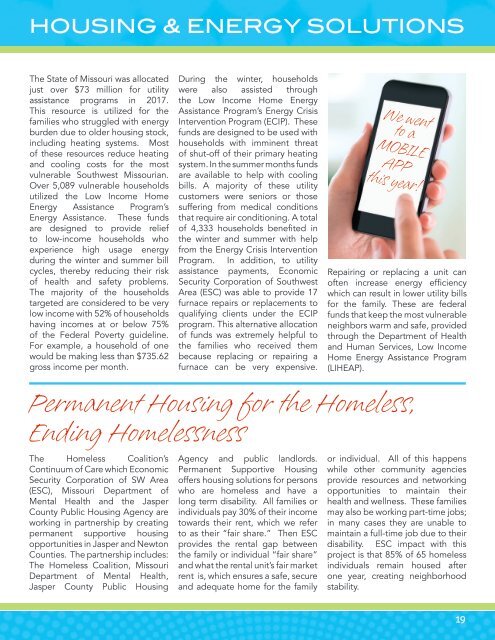ESC Annual Report 2018
Create successful ePaper yourself
Turn your PDF publications into a flip-book with our unique Google optimized e-Paper software.
HOUSING & ENERGY SOLUTIONS<br />
The State of Missouri was allocated<br />
just over $73 million for utility<br />
assistance programs in 2017.<br />
This resource is utilized for the<br />
families who struggled with energy<br />
burden due to older housing stock,<br />
including heating systems. Most<br />
of these resources reduce heating<br />
and cooling costs for the most<br />
vulnerable Southwest Missourian.<br />
Over 5,089 vulnerable households<br />
utilized the Low Income Home<br />
Energy Assistance Program’s<br />
Energy Assistance. These funds<br />
are designed to provide relief<br />
to low-income households who<br />
experience high usage energy<br />
during the winter and summer bill<br />
cycles, thereby reducing their risk<br />
of health and safety problems.<br />
The majority of the households<br />
targeted are considered to be very<br />
low income with 52% of households<br />
having incomes at or below 75%<br />
of the Federal Poverty guideline.<br />
For example, a household of one<br />
would be making less than $735.62<br />
gross income per month.<br />
The Homeless Coalition’s<br />
Continuum of Care which Economic<br />
Security Corporation of SW Area<br />
(<strong>ESC</strong>), Missouri Department of<br />
Mental Health and the Jasper<br />
County Public Housing Agency are<br />
working in partnership by creating<br />
permanent supportive housing<br />
opportunities in Jasper and Newton<br />
Counties. The partnership includes:<br />
The Homeless Coalition, Missouri<br />
Department of Mental Health,<br />
Jasper County Public Housing<br />
During the winter, households<br />
were also assisted through<br />
the Low Income Home Energy<br />
Assistance Program’s Energy Crisis<br />
Intervention Program (ECIP). These<br />
funds are designed to be used with<br />
households with imminent threat<br />
of shut-off of their primary heating<br />
system. In the summer months funds<br />
are available to help with cooling<br />
bills. A majority of these utility<br />
customers were seniors or those<br />
suffering from medical conditions<br />
that require air conditioning. A total<br />
of 4,333 households benefited in<br />
the winter and summer with help<br />
from the Energy Crisis Intervention<br />
Program. In addition, to utility<br />
assistance payments, Economic<br />
Security Corporation of Southwest<br />
Area (<strong>ESC</strong>) was able to provide 17<br />
furnace repairs or replacements to<br />
qualifying clients under the ECIP<br />
program. This alternative allocation<br />
of funds was extremely helpful to<br />
the families who received them<br />
because replacing or repairing a<br />
furnace can be very expensive.<br />
Agency and public landlords.<br />
Permanent Supportive Housing<br />
offers housing solutions for persons<br />
who are homeless and have a<br />
long term disability. All families or<br />
individuals pay 30% of their income<br />
towards their rent, which we refer<br />
to as their “fair share.” Then <strong>ESC</strong><br />
provides the rental gap between<br />
the family or individual “fair share”<br />
and what the rental unit’s fair market<br />
rent is, which ensures a safe, secure<br />
and adequate home for the family<br />
We went<br />
to a<br />
MOBILE<br />
APP<br />
this year!<br />
Repairing or replacing a unit can<br />
often increase energy efficiency<br />
which can result in lower utility bills<br />
for the family. These are federal<br />
funds that keep the most vulnerable<br />
neighbors warm and safe, provided<br />
through the Department of Health<br />
and Human Services, Low Income<br />
Home Energy Assistance Program<br />
(LIHEAP).<br />
Permanent Housing for the Homeless,<br />
Ending Homelessness<br />
or individual. All of this happens<br />
while other community agencies<br />
provide resources and networking<br />
opportunities to maintain their<br />
health and wellness. These families<br />
may also be working part-time jobs;<br />
in many cases they are unable to<br />
maintain a full-time job due to their<br />
disability. <strong>ESC</strong> impact with this<br />
project is that 85% of 65 homeless<br />
individuals remain housed after<br />
one year, creating neighborhood<br />
stability.<br />
19



